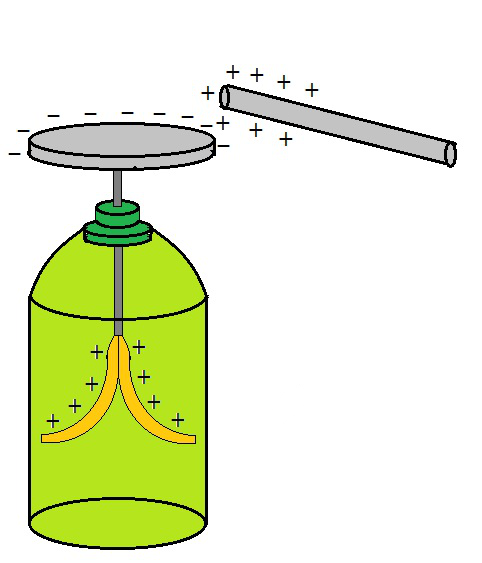验电器
大约在公元前 600 年,希腊米利都的泰勒斯 (Thales) 发现了用羊毛或丝布摩擦过的琥珀能够吸引轻物这一事实。 Electricity这个词来自希腊语Electron,意思是琥珀。众所周知,许多类似的材料对会吸引轻的东西,例如稻草、髓球和纸片,当它们摩擦在一起时会在它们之间产生吸引力。人类通过以下活动在家中获得类似的效果。应剪下细长的白纸条并轻轻熨烫。让他们靠近电视或电脑显示器。观察到条带被屏幕吸引。事实上,它在很长一段时间内都粘在电视上。
电荷
Electric charge is the fundamental physical characteristic of a matter that makes it experience a force when placed in an electric or magnetic field.
当两根玻璃棒用一块羊毛或丝布摩擦并靠在一起时,它们之间会观察到排斥力。用于摩擦棒的两股羊毛或两块丝布片也相互排斥。另一方面,玻璃棒和羊毛相互吸引。用猫毛刷过的两根塑料棒相互排斥,但会吸引猫毛。另一方面,塑料棒吸引玻璃棒并排斥用于摩擦玻璃棒的丝绸或羊毛。毛皮被玻璃棒排斥。
经过几位专家的多次严格检验,确定了一种叫做电荷的实体只有两种。电气化过程发生在玻璃或塑料棒、丝绸、毛皮和髓球的主体上。摩擦会产生电荷。根据对髓球的研究,带电有两种:同电荷相互排斥,异电荷相互吸引。调查还表明,当棒和髓球接触时,电荷从棒转移到髓球。髓球应该通过接触带电或充电。电荷的极性是区分这两种电荷的特征。
当用丝绸摩擦玻璃棒时,棒会接收一种电荷,而丝绸会接收另一种电荷。这适用于任何一对摩擦在一起的带电物品。当带电的玻璃棒与它摩擦过的丝绸接触时,它不再吸引它。它们不会像通电时那样吸引或排斥其他轻的东西。结果,当带电体接触时,摩擦过程中获得的电荷消失了。
物品累积的相反电荷的效果被中和或无效。结果,美国科学家本杰明富兰克林将这些电荷标记为正电荷和负电荷。
验电器
An electroscope is a scientific apparatus that helps in the detection of an electric charge on a body. The earliest electroscope, known as Vesorium, was a pivoting needle electroscope invented in 1600 by British physicist William Gilbert.
测试电荷的移动由库仑静电力触发,该静电力由验电器测量。验电器经常用作基本电压表,因为物体的静电荷与其电容成正比。验电器观察到的足够大的电荷浓度需要大量的伏特。
因此,验电器经常与静电和静电设备等高压源一起使用。静电计是用于测量定量静电荷的仪器。
验电器的工作
An electroscope’s operating principle is based on the atomic structure of atoms, charge induction, the internal structure of metal elements, and the premise that like charges repel each other while unlike charges attract.
验电器由两片薄金箔组成,它们连接到盒子中的垂直金属棒的底端。当带电的小工具与杆顶部的金属旋钮接触时,电荷会转移到叶子上,导致它们发散。电荷量由发散程度表示。
- 验电器金属中的电子在电荷之间具有吸引力,当电荷为正时,电子从叶子中向上传播。因此,叶子会获得短暂的正电荷,并且由于相同的电荷相互排斥,因此叶子会分开。当电荷释放时,电子返回到它们的正常位置,叶子放松。
- 当电荷为负时,验电器金属中的电子相互排斥并向底部叶片迁移。因此,叶子会暂时带上负电荷,并且由于相同的电荷相互排斥,叶子会再次分离。然后,当电荷被撤回时,电子会返回到它们的正常位置,并且叶子会放松。
一旦带电体被移除,电子在这两种情况下都会返回到它们的原始状态。此外,验电器无法确定电荷是正电荷还是负电荷。它只能检测到它在身体中的存在。
验电器的类型
以下是两种最常见的验电器,它们是:
- 髓球验电器:英国物理学家兼校长约翰·坎顿于 1754 年设计了它。它由一个或两个不导电的小球组成,这些小球用丝绸或亚麻线悬挂在封闭支架的钩子上。将物品靠近未充电的髓球,以确定其上是否存在电荷。如果测试材料的电荷为正,则分子中的电子或负电荷将被拉向它。它们转移到最接近材料分子的一侧。另一方面,带正电荷的分子,即原子核,排斥并偏离物质。通过使用髓球验电器,这种方法可用于研究材料上是否存在静电荷。

髓球验电器
- 金叶验电器:它是由英国科学家亚伯拉罕班纳特于 1787 年开发的,作为比髓球验电器更灵敏的设备。金箔验电器用于检测和分类存在于体内的电荷。它基于静电感应和排斥理论。它由一根黄铜棒制成,一端有两片细长的金叶,另一端有金属圆盘。两片薄薄的叶子以及一种导电材料,彼此平行并彼此靠近悬挂。将棒插入圆柱形玻璃罐中,让金叶留在里面,而圆盘留在外面。金箔验电器内插入少量CaCl 2以保持罐内空气干燥,下部由锡箔制成。叶子没有坚固性,胆怯地垂下,因为它们脆弱而敏感。当它们充电时,它们分开并形成一个角度,其充电电压取决于对叶子的冲击量。这个验电器上显示的是电位,而不是电荷。也可以通过观察分离角来测量电压。

金箔验电器
验电器的用途
验电器可用于以下目的,
- 其目的是检测静电荷。
- 验电器可用于确定电荷的性质。
- 验电器可用于比较两种不同电荷的大小。
导体和绝缘体
有些材料很容易使电流通过它们,而另一些则不能。导体是允许电流自由流过它们的材料。它们在材料内部具有相对自由移动的电荷(电子)。导体包括金属、人体和动物的身体,以及大地本身。大多数非金属,如玻璃、瓷器、塑料、尼龙和木材,对通过它们的电流具有很高的电阻,称为绝缘体。
导体和绝缘体之间的区别是: Conductor Insulator
感应充电
感应充电是一种充电方法,其中一个物体在不实际接触另一个带电物体的情况下充电。带电粒子被保持在不带电的导电材料附近,该导电材料在通过感应过程充电期间接地在中性带电材料上。当电荷在两个物体之间流动时,不带电的导电材料会产生与带电物体极性相反的电荷。
示例问题
问题1:取两个质量完全相同的金属球。一个被赋予正电荷q库仑,另一个被赋予相等的负电荷。它们充电后的质量是否相等?解释。
解决方案:
No, the body’s positive charge is caused by an absence of electrons, whereas the negative charge is caused by an abundance of electrons. As a result, the negatively charged sphere will have a somewhat higher mass than the positively charged spheres.
问题2:6×10 -6 C 的正电荷距离第二个4×10 -6 C 的正电荷0.040 m。计算电荷之间的力。
解决方案:
Given,
A positive charge q1 is 6×10-6 C.
The second positive charge q2 is 4×10-6 C.
The distance between the charges r is 0.040 m.
![]()
Substitute the values in the above expression,

问题3:验电器是什么?
解决方案:
An electroscope is a scientific apparatus that helps in the detection of an electric charge on a body. The earliest electroscope, known as Vesorium, was a pivoting needle electroscope invented in 1600 by British physicist William Gilbert.
The movement of the test charge is triggered by the Coulomb electrostatic force, which is measured by an electroscope. Electroscopes are frequently used as basic voltmeters since an object’s electrostatic charge is proportional to its capacitance. A large enough concentration of charge to be observed by an electroscope necessitates numerous volts. As a result, electroscopes are frequently used with high-voltage sources like static electricity and electrostatic devices. An electrometer is an instrument used to measure the quantitative electrostatic charge.
问题 4:解释验电器的工作原理?
解决方案:
An electroscope’s operating principle is based on the atomic structure of atoms, charge induction, the internal structure of metal elements, and the premise that like charges repel each other while unlike charges attract. An electroscope is made up of two thin gold leaves joined to the bottom end of a vertical metal rod contained in a box. When a charged gadget comes into contact with the metal knob at the top of the rod, the charge is transferred to the leaves, causing them to diverge. The amount of charge is indicated by the degree of divergence.
- Electrons in the metal of the electroscope have an attractive force between the charge and travel upward out of the leaves when the charge is positive. The leaves gain a brief positive charge as a result of this, and because like charges repel each other, the leaves separate. The electrons return to their normal locations when the charge is released, and the leaves relax.
- When the charge is negative, the electrons in the electroscope’s metal reject each other and migrate toward the bottom leaves. The leaves get a momentary negative charge as a result of this, and because like charges repel each other, the leaves separate once more. The electrons then return to their normal location when the charge is withdrawn, and the leaves relax.
As soon as the charged body is removed, the electrons return to their original state in both circumstances. Furthermore, the electroscope cannot determine whether a charge is positive or negative; it can only detect its presence in a body.
问题 5:线密度为 λ 的均匀线电荷位于 y 轴上。多少通量穿过以 r = R 为原点的球面。
解决方案:
Given,
Line charge density is λ.
The radius of the surface is R.
The length of wire inside the sphere is 2R.
Now, λdl=dθ
For total charge enclosed by radius R is
Now, ϕ = Qinc/εo
or
ϕ = 2λR/εo